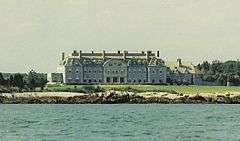Round Hill (Dartmouth, Massachusetts)

Round Hill is a location in Dartmouth, Massachusetts of historical significance.
History

Edward Howland Robinson Green, known as "Colonel" Ned Green, the only son of the renowned female tycoon and miser, Hetty Green, built his home on Round Hill after his mother's death in 1916 left him with a fortune of between $100 and $200 million. The mansion was designed by architect Alfred C. Bossom and completed in 1921 at a cost of $1.5 million.
In 1948, twelve years after the Colonel's death, his sister Sylvia Green, his heir, donated the entire property to the Massachusetts Institute of Technology (MIT), which used the 240-acre (0.97 km2) estate for educational and military purposes until 1964. MIT erected a giant antenna atop a 50,000-gallon water tank on the site. Another was erected nearby for research towards the Ballistic Missile Early Warning System. The giant dish antenna stood as a local and marine navigational landmark until the current owners of the site, the Bevelaqua family, demolished it in 2007.
In 1964 MIT sold the estate to the Society of Jesus of New England. It adapted the mansion as a religious retreat center. Its upper floors were converted into 64 individual rooms, and its main floor reworked to include a chapel, conference rooms, and library. In 1968 the Jesuits sold much of the estate's beach to the Town of Dartmouth. In 1970 it sold the entire property to Gratia R. Montgomery, a local woman. In 1981 she sold most of the site to private developers. They developed it as a private, gated condominium community.
Radio WMAF

In 1923, (as continuous-wave broadcasting became available), Colonel Green founded WMAF, a radio station with the tag, "The Voice from Way Down East". MIT's President, Samuel W. Stratton and the Department of Electrical Engineering's new Communications Division were invited to experiment with the new technology, and the department was initially financed by Colonel Green.
Professor Edward L. Bowles set out to determine the signal strength and radiation patterns of different antenna arrays in 1926. Round Hill's radio station (which included an early radio telescope, built on the foundation of a lighthouse) followed Donald B. MacMillan's and Admiral Richard E. Byrd's polar expeditions, tracked the Graf Zeppelin dirigible during its maiden transatlantic flight, and was the sole communication link for areas devastated by the Vermont floods in 1927.
Van de Graaff
In 1933, Round Hill was the site of Robert J. Van de Graaff's electrical experiments. He built a 40-foot (12 m) tall Van de Graaff generator in an abandoned airship hangar. The generator was donated in 1956 to the Museum of Science, Boston, and circa 2011 the generator continues to function as a major exhibit.
Charles W. Morgan
The New Bedford whaling ship Charles W. Morgan, now on display at Mystic Seaport, was once owned in part by Colonel Green, and moored at Round Hill.
World War II
During World War II, the Coast Artillery built a fire control structure on the site.
Recent developments
In 2007 the property was bought for around $8.5 million.[1] On November 19, 2007, the antenna was demolished by the new owner, who planned to build a new home on the site.[2]
References
- ↑ Hartnett, Ken (April 4, 2007). "Historical radar tower may become extinct". SunCoast Today. Retrieved 13 December 2009.
- ↑ John Sladewski. "Martini tumbler / Round Hill bids farewell to radar tower". New Bedford Standard-Times.
External links
General
- The Center for Land Use Interpretation's page about the Round Hill Lab Site
- A citation of "84 cubic feet" of records that mention "Round Hill, an estate left to the Institute by E. H. R. Green as a home for research in aeronautics and microwave technology"
- About Round Hill Community
- PALATIAL HOME FOR COLONEL E.H.R. GREEN SON OF HETTY GREEN "...probably be one of the finest and most imposing country dwellings in the East."
- The Voice From Way Down East - 1923 WMAF promotion brochure
Robert J. Van de Graaff
- A short history of Van de Graaff's work at Round Hill
- Photos from a 1933 report on Van de Graaff's generator at Round Hill